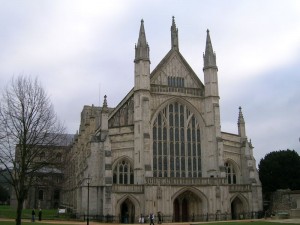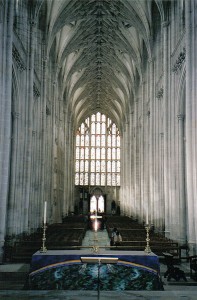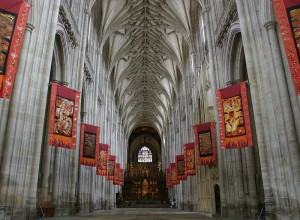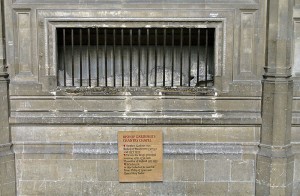“Anne Boleyn was not a catalyst in the English Reformation; she was a key element in the equation.”
(Eric Ives, Pg. 260)
During the Progress of 1535 Queen Anne Boleyn and Thomas Cromwell worked together to appoint a number of ‘sympathetic’ new bishops to vacancies that had arisen for a variety of reasons.
John Fisher’s execution left a vacancy in Rochester, as did Charles Booth’s death in Hereford. In May 1535, ‘Parliament passed an Act seizing the English sees held by Henry’s Italian agents at the Papal Court’ (Starkey, Pg. 535) thus creating vacancies in Salisbury and Worcester where Campeggio and Ghinucci had once ruled the roost.
So Queen and Minister worked together in the appointment of ‘thorough-going Reformers’ (Starkey, Pg. 535).
Anne Boleyn’s Almoner, Nicholas Shaxton, was the first new appointment to Salisbury. Edward Foxe, the theoretician of the Divorce and Supremacy got Hereford, Hugh Latimer Worcester and John Hilsey Rochester (Starkey, Pg. 536).
The Progress now culminated in Winchester Cathedral, ‘the setting for one of the most extraordinary scenes of the Reformation’ (Starkey, Pg. 538).
In mid-September Dinteville, who had been painted by Holbein in The Ambassadors, arrived with some disturbing news. Clement VII had died in 1534 and had been succeeded as Pope by Alessandro Farnese, Paul III.
Starkey describes how the new Pope was ‘outraged by Henry’s conduct, and the beheading of Fisher, whom he had made a Cardinal just before his execution’ (Pg. 538).
This was apparently the last straw for the new Pope and in late July at the College of Cardinals, Pope Paul III ‘deprived Henry of his kingdom and royal dignity’ and wrote a ‘Brief or letter to Francis to ask him to give effect to the sentence’ (Starkey, Pg. 538).
Francis though had his own plans and decided to use the letter as ‘diplomatic blackmail’ to try and secure English support for renewed French intervention in Italy. His plan though did not play out as he had hoped as Henry was in no mood for foreign expeditions.
Dinteville left England after two weeks and Henry VIII summoned the leading bishops to an emergency meeting. Those in attendance included Cranmer, the Bishop of Winchester and Stephen Gardiner (Starkey, Pg. 538).
But before the meeting was even underway, Henry and Anne used the opportunity to stage a major ceremony. Starkey describes how since the break with Rome, ‘the consecration of English bishops had been hole-in-corner affairs – performed, like Cranmer’s and Shaxton’s, in the decent obscurity of St Stephen’s Chapel’ (Pg. 539).
This was all about to change.
On September 19, at Winchester Cathedral, Cranmer consecrated the three most recently appointed bishops, Foxe, Latimer and Hilsey and all this in the presence of ‘the cream of the English episcopate’ (Starkey, Pg. 539).
According to both Eric Ives and David Starkey, Henry and Anne were almost certainly present for this momentous occasion. Queen Anne showing her support for ‘her’ new bishops and Henry sending a clear and defiant message to the Pope and to those that doubted his Supreme authority at home.
In Starkey’s words, Anne ‘started to shape an episcopate in the image of her own Reforming piety.’ (Pg. 539).
Apart from being a location significant to Anne Boleyn enthusiasts, the Cathedral was also the setting for Queen Mary I’s marriage to King Phillip II of Spain and for lovers of literature, is also home to the tomb of Jane Austen.
The Cathedral is also renowned for its chantry chapels, where daily masses were said for the bishops buried within them. Among the chapels is that of Bishop Gardiner’s, described as ‘an amazing hybrid of English late Gothic and Continental Renaissance style.’
Other important events that took place at Winchester Cathedral include:
- Funeral of King Harthacanute (1042)
- Funeral of King William II of England (1100)
- Coronation of Henry the Young King and his queen, Marguerite (1172)
- Second coronation of Richard I of England (1194)
- Marriage of King Henry IV of England and Joanna of Navarre (1403)
For more information on the historic and incredibly important stop On the Tudor Trail visit the Cathedral’s official website here.
All are welcome to visit the Cathedral as visitors or pilgrims. Opening times:
9am – 5pm – Monday to Saturday
12.30pm – 3pm – Sunday
Opening times may vary for special services and events and so it’s recommended that you check the Cathedral’s closures list if making a special visit.
Sources: Ives, E. The Life and Death of Anne Boleyn, 2004. Starkey, D. Six Wives: The Queens of Henry VIII, 2004. http://www.winchester-cathedral.org.uk/ http://en.wikipedia.org/wiki/Winchester_Cathedral Image Sources: Image 1- Winchester Cathedral Image 2- View along the central nave Image 3- The nave looking east Image 4- Stephen Gardiner’s chantry tomb




















Thanks for a great piece–I hope to get there one day and see it in person! This is such a great site by the way.
Thank you Anne! I am so glad that you continue to find the site useful